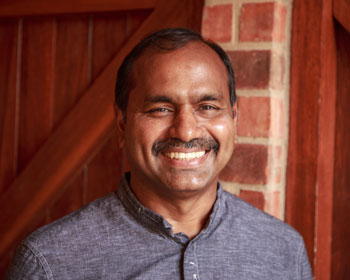Families in cities are turning into islands of existence resulting in growing physical and psychological stress. One of the ways of getting around this is to opt for community living spaces that offer diversity in both landscape and people – essentially bringing back the village culture that has soul and a unique identity.
Stanley George and a bunch of his friends are one of the very few who have mastered the concept, design and execution of building sustainable community living homes across India with their experience of nearly two decades.
Excepts of his chat with Benedict Paramanand, Editor of SustainabilityNext
How did you start?
I’m a civil engineer. Along with a group of 8 friends we started an NGO in the 80s in Cochin. We were inspired by the great architect Laurie Baker. (Watch Uncommon Sense: The Life and Work of Laurie Baker). Laurie was inspired by Mahatma Gandhi’s principle that most of the material for building a house should be sourced from within five kilometers radius.
We started a professional firm and launched the sustainable design and consultancy business. Just like Laurie, we also got branded as ‘low cost’ architects from the beginning. That stigma has stayed with us although every project we did was rich in all aspects. We made mistakes along the way but people were appreciative of our integrity.
Along the way we felt the need to have greater influence on the projects we were doing but were not able to. Some of us ventured into development in 1994 in Cochin. The 1998 economic recession hit us badly but since we had the skill set we could sustain.
We wanted to explore beyond Cochin and moved in Bangalore. Our first community housing project of 54 homes came up in 2004 near Kengeri. The success of this project gave us confidence to venture into this segment fully.
 Our big project was Good Earth Orchard. It was the first organized development project in Bangalore. Orchard gave us a lot of visibility and confidence. We have so far completed 400 homes of various types.
Our big project was Good Earth Orchard. It was the first organized development project in Bangalore. Orchard gave us a lot of visibility and confidence. We have so far completed 400 homes of various types.
How do you go about?
We interact with ecologists and nature experts when we sign any project. We try to give these projects a local flavor since each town has its own unique soul. Like Mysore has a soul of its own, even Tumkur has its own unique culture.
We do customize the experience but guide the project in such a way that they have diversity of people occupying them, diversity of plant species are cultivated and provide spaces for informal meetings. We do this by ensuring homes are priced differently where even middle class families can afford. So our communities have doctors, authors, scientists along with corporate executives.
Design is very important in the sustainable communities’ space. Essentially, people have to experience the place. People are rediscovering the value of informality of living spaces.
Your business success factors
We believe in decentralized format of doing business. Each partner runs his business in a city under the common brand name. We deliberately remain low key. I believe humility, integrity and hard work are important in business. We enjoy our work and experience joy while creating all our buildings.
The term ‘green entrepreneur’ has become a cliché. True green goes much deeper – understanding spirituality in nature and using that while conceiving homes and buildings. Technology is over rated.
Your views on senior homes
I believe elders should live with youngsters – supportive element is important. What one needs is organized infrastructure. Sustainable community is for everybody – senior citizens – professionals and kids.
The idea of a senior home is disconnected. The argument that they offer better medical support is over rated. Medical support can always be provided in our community homes. People who conceive such business models are insensitive.
You are a proponent of timber-centric economy
India could easily become a highly lucrative timber-centric economy because of its natural advantages. Leave the forests alone. There is enough land area to grow timber in the country. A flourishing timer-centric economy offers several advantages – helps local communities with raw materials, offers employment to locals, protects forests and enhances the ecology of areas around them. We have to shed mono culture and encourage multi-species cultivation.
Lack of clear policy, ambiguity of titles and poor legal protection are hampering this vital sector. We are now importing timber.
Ecology and management of the environment should not be the sole responsibility of the government. Citizens should take serious interest. A holistic approach to ecology will be great for India.
India has 136 species of bamboo. An aggressive and well-conceived bamboo cultivation strategy can provide a lot of employment, cheaper raw material for the construction sector and helps the ecology tremendously.
Future of Green Earth
We now have an overall experience of 30 years which we are eager to share with the younger generation. We would like to take up mentoring in architecture and engineering schools.
The good news is various communities from across the country are approaching us for our expertise and knowledge for conceiving their community projects. I have advised teams from as far as Leh and Srinagar. Several spiritual groups are also getting into this space.
We don’t have one formula for everyone. We help each of them customize to their local environment and culture. Always, the devil is in the detail. This comes with a lot of practical experience.
We are happy to engage with the education system to bring in practical experience, love for environment and spiritual elements into it.
India has all the elements to become a model in sustainable ecology design and architecture. The fact that it worships nature is its biggest asset.
Affordable green homes
As India builds its cities, effective and cheap public transport system is fundamental. With this even middle and lower middle class customers can purchase sustainable homes outside the city and travel to work.
It is a misconception that green sustainable homes are expensive. If you take out the land cost, we don’t need to use expensive material at all. Local material and local labor can make it affordable and yet rich in aesthetics and experience.
It’s ideal for group of people to purchase land and take up sustainable community home construction with support from people like us. The overall cost can come down by more than one-third.
Buying land is not easy. Chandrababu Naidu, CM of Andhra Pradesh, implemented title certification recently making purchasing of land simple and safe. This could happen in all states with the government as the guarantor. This will revolutionize the construction sector in India.
Mid-size is Ideal
I’m against scale for the sake of scale. To me, mid size is the right size. If u scale too much and too fast you lose focus. One has to be extremely careful. One need not be greedy. Scaling can take away the soul.








Excellent coverage acknowledging the soul of an Organisation present and nurtured by the founder Stanley a role model of a nature visionary whe cares deeply for those who come to live in his paradise communities.